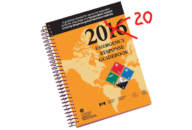It’s hot, right? Mid-summer is here with tremendous heat and we all have to protect our employees. Remember the basics: provide plenty of water, make sure employees take more frequent breaks in a cool area, caution them against overexertion in the heat, and keep an extra eye open for people struggling in the weather. Let’s all do our…
DG Digest: ADR to go Global, Could Drop “European Union (EU)” from Title
Monday the 27th marked our nation’s Memorial Day honoring fallen military veterans. The Labelmaster family joins our fellow Americans in expressing gratitude for their sacrifice. It was a middling busy week on the regulatory front; here’s the latest: OSHA The agency announced that on Thursday, June 20, 2019, OSHA will conduct a public meeting to…
DG Digest: PHMSA seeks nominees for first ever lithium battery committee
We begin the final month of the spring with a fairly busy week. Before too long the summer vacation and holiday season will begin; it’s easy for some employees to become a little preoccupied. Let’s make sure we all keep focused on the safety of our workplace! It’s been a busy week in the regulatory…
DG Digest: PHMSA to hold public meeting on 2020 ERG
Sunday was Mothers’ Day; here’s hoping all the Moms out there got the “royal treatment.” Thank you for all you do! The week was a little busy in the regulatory sense; here’s all the latest: FAA The agency published a proposed new ICR that will affect the manufacturers of small unmanned aircraft (drones) and that…
Can one compliance gap ruin your bottom line? Ask the Night King.
We all know Game of Thrones, the hit series currently in its final season on HBO, is really about hazmat transport. Fittingly, Sunday night’s episode 3 supplied a metaphor that every supply chain organization should take to heart. Spoiler alert: If you aren’t current on Game of Thrones, skip the next two paragraphs! The episode…
DG Digest: EPA proposes to amend TSCA reporting for small manufacturers
The last two weeks of April featured improving weather across the United States, and then a late season snow storm hit east of the Mississippi! Make sure your workplace’s cold weather and snow removal plans are still effective and protect those employees. Regulatory action was varied across the time period, with EPA action in reference…
How is hazmat shipping like your favorite sport (and how do you win)?
It’s a great time of year to be a sports fan. The NBA and NHL playoffs (WOW! What a first round…) are at full throttle, Major League Baseball is back and the NFL draft is right around the corner. The athletes who play those sports are the best in the world at what they do.…
Add your voice to the 4th annual Dangerous Goods Confidence Outlook
Labelmaster, Hazardous Cargo Bulletin (HCB) and IATA invite you to participate in the world’s most comprehensive survey of hazmat professionals. The revealed results of the annual Dangerous Goods Confidence Outlook have become a tradition at the Dangerous Goods Symposium. A few insights usually take the crowd by surprise, and you hear reactions like: I’ve always…
DG Digest: PHMSA issues Emergency Waiver No. 13 for areas affected by severe flooding
Mid-April snow snarled much of the nation over the weekend, but it’s also now the culmination of tax season. Transport regulations may not be topping everyone’s list of things to think about this week; however, plenty of action took place all the same. Here’s the latest: PHMSA The agency published Emergency Waiver No. 13. This waiver…
The hazmat pro’s guide to Game of Thrones, Season 8
At last, the moment for which hazmat pros have waited untold winters! The final season of Game of Thrones starts Sunday. Everyone in the Dangerous Goods galaxy knows Game of Thrones is really about hazmat transport. For all its swordplay, palace intrigue and dragons, the show addresses the same issues hazmat pros deal with every…









